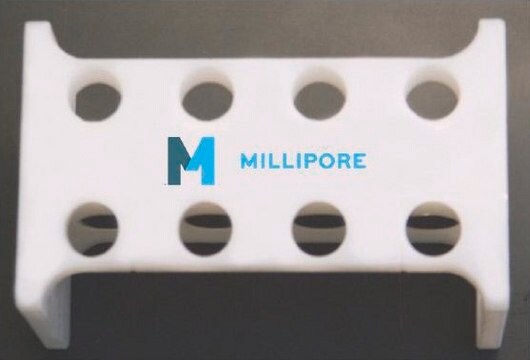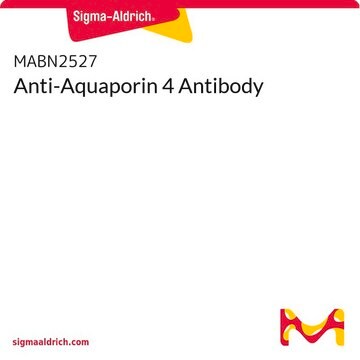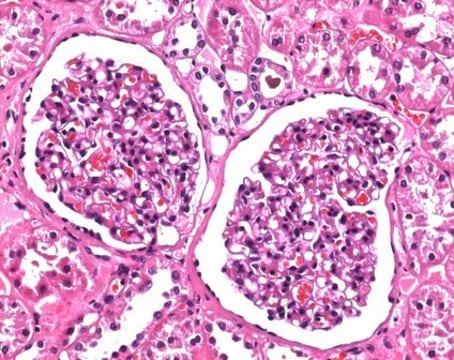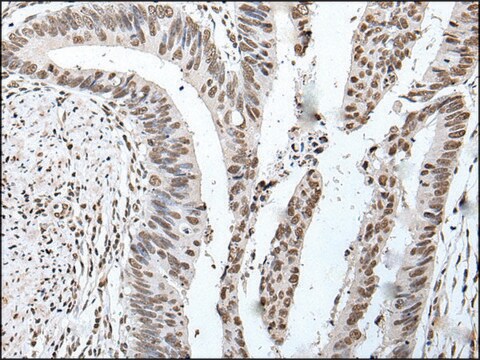Recommended Products
biological source
mouse
Quality Level
conjugate
unconjugated
antibody form
purified antibody
antibody product type
primary antibodies
clone
43B7, monoclonal
mol wt
calculated mol wt 71.44 kDa
observed mol wt ~70 kDa
purified by
using protein G
species reactivity
human
packaging
antibody small pack of 100 μg
General description
Protection of telomeres protein 1 (UniProt: Q9NUX5; also known as hPot1, POT1-like telomere end-binding protein) is encoded by the POT1 gene (Gene ID: 25913) in human. POT1 is a component of the double-stranded telomeric DNA-binding TRF1 complex which is involved in the regulation of telomere length by cis-inhibition of telomerase. As a component of the shelterin complex, it is involved in the regulation of telomere length and protection. It also acts as a single-stranded telomeric DNA-binding protein and thus may act as a downstream effector of the TRF1 complex and may transduce information about telomere maintenance and/or length to the telomere terminus. It binds to two or more telomeric single-stranded 5′-TTAGGG-3′ repeats (G-strand) and with high specificity to a minimal telomeric single-stranded 5′-TAGGGTTAG-3′ sequence. Its DNA binding domains are localized to amino acids 33-48 and 270-273. POT1 contains two copies of oligonucleotide oligosaccharide-binding fold (OB-fold) domains in its N-terminal half that are responsible for single strand DNA binding activity. TPP1, a shelterin component, plays critical role in chromosome end protection and telomere length regulation and POT1 is shown to negatively regulate TPP1 phosphorylation at serine Ser255 by NIMA Related Kinase 6 (NEK6). (Ref.: Hirai, Y., et al. (2016). Genes Cells 21(8); 874-889; Hirai, Y., et al. (2012). Genes Cells. 17(3); 186-204).
Specificity
Clone 43B7 is a mouse monoclonal antibody that detects human Protection of telomeres protein 1 (POT1).
Immunogen
Full-length recombinant human Protection of telomeres protein 1 (POT1).
Application
Quality Control Testing
Evaluated by Western Blotting in HeLa cell lysate.
Western Blotting Analysis: A 1:1,000 dilution of this antibody detected Protection of telomeres protein 1 (POT1) in HeLa cell lysate.
Tested Applications
Western Blotting Analysis: A 1:1,000 dilution from a representative lot detected POT1 in HEK293T, HepG2, and K562 cell lysates.
Immunofluorescence Analysis: A representative lot detected POT1 in Immunofluorescence application. (Hirai, Y., et al. (2012). Genes Cells. 17(3):186-204).
Immunoprecipitation Analysis: A representative lot immunoprecipitated POT1 in Immunoprecipitation application. (Hirai, Y., et al. (2012). Genes Cells. 17(3):186-204; Hirai, Y. et al. (2016). Genes Cells. (8): 874-889).
Chromatin Immunoprecipitation Analysis (ChIP): A representative lot detected POT1 in Chromatin Immunoprecipitation applications (Hirai, Y., et al. (2012). Genes Cells. 17(3):186-204).
Western Blotting using knockout lysates: A representative lot detected POT1 in wild-type, but not in KO lysates in Western Blotting application. (Hirai, Y., et al. (2012). Genes Cells. 17(3):186-204).
Western Blotting Analysis: A representative lot detected POT1 in Western Blotting application. (Hirai, Y. et al. (2016). Genes Cells. (8): 874-889).
Note: Actual optimal working dilutions must be determined by end user as specimens, and experimental conditions may vary with the end user
Evaluated by Western Blotting in HeLa cell lysate.
Western Blotting Analysis: A 1:1,000 dilution of this antibody detected Protection of telomeres protein 1 (POT1) in HeLa cell lysate.
Tested Applications
Western Blotting Analysis: A 1:1,000 dilution from a representative lot detected POT1 in HEK293T, HepG2, and K562 cell lysates.
Immunofluorescence Analysis: A representative lot detected POT1 in Immunofluorescence application. (Hirai, Y., et al. (2012). Genes Cells. 17(3):186-204).
Immunoprecipitation Analysis: A representative lot immunoprecipitated POT1 in Immunoprecipitation application. (Hirai, Y., et al. (2012). Genes Cells. 17(3):186-204; Hirai, Y. et al. (2016). Genes Cells. (8): 874-889).
Chromatin Immunoprecipitation Analysis (ChIP): A representative lot detected POT1 in Chromatin Immunoprecipitation applications (Hirai, Y., et al. (2012). Genes Cells. 17(3):186-204).
Western Blotting using knockout lysates: A representative lot detected POT1 in wild-type, but not in KO lysates in Western Blotting application. (Hirai, Y., et al. (2012). Genes Cells. 17(3):186-204).
Western Blotting Analysis: A representative lot detected POT1 in Western Blotting application. (Hirai, Y. et al. (2016). Genes Cells. (8): 874-889).
Note: Actual optimal working dilutions must be determined by end user as specimens, and experimental conditions may vary with the end user
Anti-POT1, clone 43B7, Cat. No. MABE1907, is a mouse monoclonal antibody that detects POT1 and is tested for use in Chromatin Immunoprecipitation, Immunofluorescence, Immunoprecipitation, Western Blotting, and Western Blotting using KO lysates.
Physical form
Purified mouse monoclonal antibody IgG2a in buffer containing 0.1 M Tris-Glycine (pH 7.4), 150 mM NaCl with 0.05% sodium azide.
Storage and Stability
Recommend storage at +2°C to +8°C. For long term storage antibodies can be kept at -20°C. Avoid repeated freeze-thaws.
Other Notes
Concentration: Please refer to the Certificate of Analysis for the lot-specific concentration.
Disclaimer
Unless otherwise stated in our catalog or other company documentation accompanying the product(s), our products are intended for research use only and are not to be used for any other purpose, which includes but is not limited to, unauthorized commercial uses, in vitro diagnostic uses, ex vivo or in vivo therapeutic uses or any type of consumption or application to humans or animals.
Not finding the right product?
Try our Product Selector Tool.
Storage Class
12 - Non Combustible Liquids
wgk_germany
WGK 1
flash_point_f
Not applicable
flash_point_c
Not applicable
Certificates of Analysis (COA)
Search for Certificates of Analysis (COA) by entering the products Lot/Batch Number. Lot and Batch Numbers can be found on a product’s label following the words ‘Lot’ or ‘Batch’.
Already Own This Product?
Find documentation for the products that you have recently purchased in the Document Library.
Our team of scientists has experience in all areas of research including Life Science, Material Science, Chemical Synthesis, Chromatography, Analytical and many others.
Contact Technical Service






